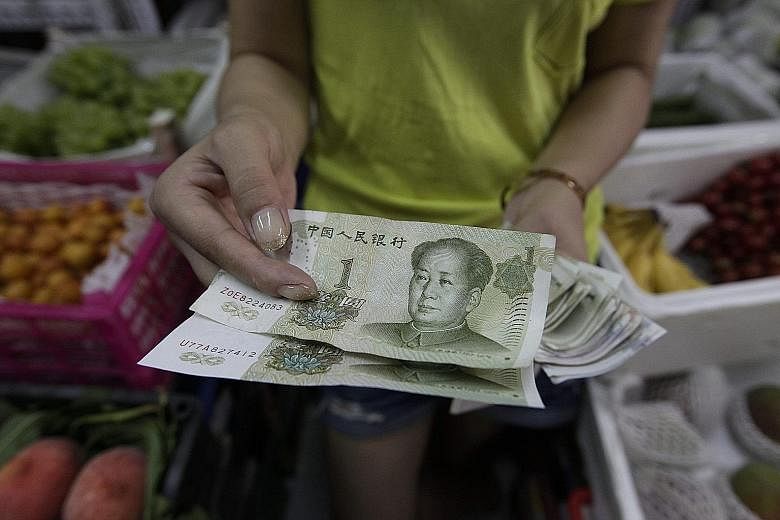Q Is the Chinese currency, the yuan, still undervalued? Why?
A On May 26, the International Monetary Fund (IMF), which used to claim that the yuan was undervalued by as much as 27 per cent, stated in one of its mission reports that the Chinese currency is no longer undervalued.
The preliminary statement has yet to be approved by the global body's executive board to be considered official. But the executive board is unlikely to overrule the mission report.
Also in May, Dr William Cline, an economist working for the Peterson Institute for International Economics (PIIE) and a longtime researcher on exchange rates, stated that "for the first time China's currency is not found to be undervalued". Dr Cline estimated that the yuan was undervalued by around 20 per cent in 2008-2009, 15 per cent in 2010-11, and only 2 per cent to 5 per cent in 2012-2014. For the first six months of this year, Dr Cline's estimate suggested a 0.1 per cent overvaluation of the yuan.
Yesterday, the Chinese government weakened the daily reference rate of the yuan by 1.9 per cent, which effectively depreciated the yuan by about the same amount. This surprise move seems to suggest the Chinese government is on the same page here: They regard the yuan as slightly overvalued.
What are the rationales behind these statements?
First, the yuan has already appreciated significantly over the past decade. Since 2005, when China moved away from a fixed exchange rate, the yuan has appreciated by around 34 per cent against the US dollar. Of course, appreciation itself does not imply that the yuan is no longer undervalued. The real question is: What is the "fair" value of the yuan?
The first way to evaluate the "fair" exchange rate of the yuan relies on trade flows such as exports and imports. The basic idea is straightforward: An undervalued yuan means the goods exported by China are cheaper when priced in foreign currencies, and thus easier to sell in the foreign markets.
Similarly, the goods imported into China are more expensive when priced in yuan, and thus are harder to sell in the Chinese market.
As a result, an undervalued yuan usually implies that China exports more than it imports, and thus runs a positive net export, or in the jargon of economics, a current account surplus.
This relationship is often used to estimate the fair exchange rate of a currency - roughly speaking, if a currency is at its fair value, we expect the country's current account balance to be close to zero.
The World Bank reports that the current account surplus of China was about 1.9 per cent of its gross domestic product last year. This number is well within a reasonable range for large exporters. For example, the same statistic was 6.5 per cent for Germany, 6.2 per cent for South Korea, and 0.7 per cent for Japan in the same year.
The current account-to-GDP ratio used to be as high as 10 per cent in China in 2007, when the yuan was generally considered undervalued, and had gradually declined as the currency appreciated over the years. Without any formal estimation, these numbers alone suggest that the yuan is no longer undervalued as of today.
Another way to gauge the fair value of a currency is through prices. The general idea is the "law of one price": If a good is traded across national borders, the prices shall be roughly the same in both countries.
Therefore, large differences in prices imply that the exchange rate between the two currencies is not "correct". The most famous example is the "Big Mac Index", maintained by The Economist, which unsurprisingly, compares the prices of Big Mac burgers across countries.
Last month, the average price of a Big Mac in the US was US$4.79 (S$6.60). In China it was only US$2.74 at the market exchange rates. Therefore, the Big Mac Index says that the yuan was undervalued by around 43 per cent.
More complicated estimates using prices of a basket of goods point to the same conclusion: The Organisation for Economic Cooperation and Development reports that the yuan was undervalued by around 40.5 per cent as compared with the purchasing-power-parity (PPP) adjusted exchange rate last year.
At first glance, it seems that by price measures, the yuan is still undervalued. However, directly comparing prices across countries can be misleading. As noted by Dr Bela Balassa and Dr Paul Samuelson in 1964, price levels can be lower in poorer countries simply because their productivity is lower in the tradable sectors.
This means that directly inferring the "fair" exchange rates from price levels can lead to the wrong conclusion that the currencies from poorer countries are undervalued. After taking the income levels into consideration, Mr Martin Kessler and Dr Arvind Subramanian from the PIIE estimated that the yuan was only undervalued by around 1.7 per cent in 2011 using PPP-adjusted prices.
Many will still claim that the yuan is undervalued based on the observation that the Chinese government is actively engaged in the market to control the exchange rate.
However, the above numbers suggest that if China allows the yuan to float fully in the near future, the market exchange rate will not drift too far away from today's value.
• The writer is an assistant professor in the Department of Economics, National University of Singapore.
• This is a monthly series by the NUS Economics Department. Each month, a panel will address a topical issue. If you have a burning question on economics, write to stopinion@sph.com.sg with "Ask NUS" in the subject field.


